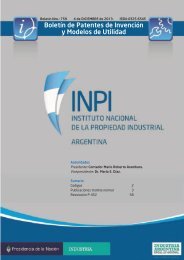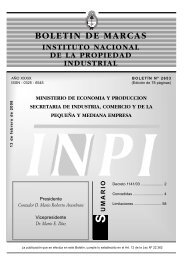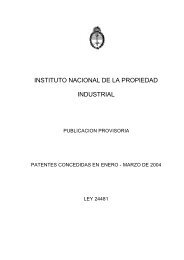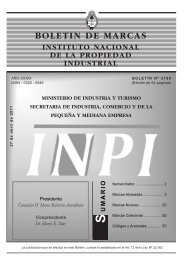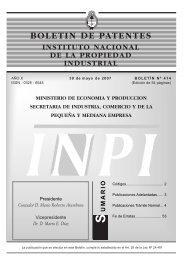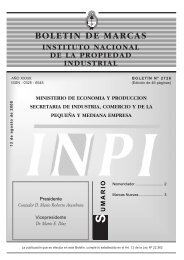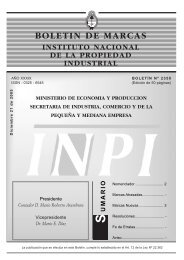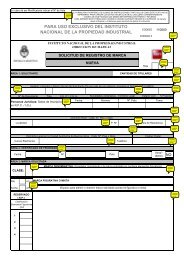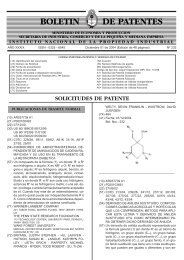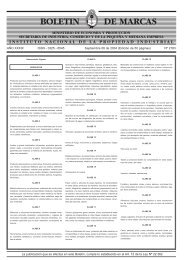2009_2 - Instituto Nacional de la Propiedad Industrial
2009_2 - Instituto Nacional de la Propiedad Industrial
2009_2 - Instituto Nacional de la Propiedad Industrial
Create successful ePaper yourself
Turn your PDF publications into a flip-book with our unique Google optimized e-Paper software.
PATENTES CONCEDIDAS <strong>2009</strong><br />
ABRIL - JUNIO<br />
___________________________________________________________________________________<br />
un saquito, el cual está sel<strong>la</strong>do alre<strong>de</strong>dor <strong>de</strong> todo<br />
su perímetro; y -una composición <strong>de</strong> limpieza<br />
efervescente en forma <strong>de</strong> un sólido seco anhidro<br />
posicionado <strong>de</strong>ntro <strong>de</strong>l saquito, <strong>la</strong> composición<br />
incluye: (i) entre el 1 y el 80% <strong>de</strong> un material<br />
alcalino; (ii) entre el 0,5 y el 80%, <strong>de</strong> un material<br />
ácido; y (iii) entre el 0,1 y el 30% <strong>de</strong> un<br />
tensioactivo sólido.<br />
Siguen 9 reivindicaciones.<br />
#8(71) Titu<strong>la</strong>r - UNILEVER N.V.<br />
WEENA 455, AL ROTTERDAM 3013, NL<br />
#8(72) Inventor - FARRELL, LINDA - ZNAIDEN,<br />
ALEXANDER PAUL - SLAVTCHEFF, CRAIG<br />
STEPHEN - VINSKI, PAUL<br />
#8(74) Agente/s 108<br />
-------------------------------------------------------<br />
<br />
#8(10) Patente <strong>de</strong> invención<br />
#8(11) Resolución N° AR050191B1<br />
#8(21) Acta N° P 20050103170<br />
#8(22) Fecha <strong>de</strong> Presentación 29/07/2005<br />
#8(24) Fecha <strong>de</strong> resolución 30/06/<strong>2009</strong><br />
#8(--) Fecha <strong>de</strong> vencimiento 29/07/2025<br />
#8(30) Prioridad convenio <strong>de</strong> Paris ES U 200401863<br />
30/07/2004<br />
#8(51) Int. Cl. F23N 5/10, 5/24, 5/02, F23D 14/06,<br />
14/72<br />
#8(54) Titulo - TERMOPAR DE SEGURIDAD DE<br />
LLAMA ADAPTADO A UN QUEMADOR DE GAS<br />
DE COCCION CON ORIFICIOS DE SALIDA<br />
RADIALES<br />
#8(57) Reivindicación 1: Termopar <strong>de</strong> seguridad <strong>de</strong><br />
l<strong>la</strong>ma es adaptado a un quemador (BU) <strong>de</strong> gas<br />
<strong>de</strong> cocción con orificios (BU) <strong>de</strong> gas <strong>de</strong> cocción<br />
con orificios <strong>de</strong> salida radiales, el cual produce<br />
una l<strong>la</strong>ma <strong>la</strong>rga (F1) y una l<strong>la</strong>ma corta (F2), el<br />
termopar (10) siendo <strong>de</strong>l tipo <strong>de</strong> cabeza sensible<br />
(11,12) y cuerpo cilíndrico (13,14) construidos<br />
mediante una funda metálica (11-14) <strong>de</strong> longitud<br />
total (H) <strong>de</strong>terminada y una varil<strong>la</strong> termoeléctrica<br />
interna (15), encerrando al menos una junción<br />
caliente (HJ1, Hk2) soldada en un extremo<br />
superior (11) <strong>de</strong> <strong>la</strong> cabeza sensible, en don<strong>de</strong> <strong>la</strong>s<br />
l<strong>la</strong>mas <strong>la</strong>rga (F1) y corta (F2) son dirigibles a <strong>la</strong><br />
cabeza sensible (11,12) en dirección transversal<br />
al eje (A) <strong>de</strong>l termopar, para <strong>la</strong> generación <strong>de</strong> <strong>la</strong><br />
e.m.f(mV) (18l,18S,18C) necesaria para <strong>la</strong><br />
alimentación <strong>de</strong> una válvu<strong>la</strong> (SV) <strong>de</strong> gas <strong>de</strong><br />
seguridad con actuador electromagnético<br />
provisto <strong>de</strong> un valor umbral Ve <strong>de</strong> enganche <strong>de</strong> <strong>la</strong><br />
armadura durante el calentamiento <strong>de</strong>l termopar,<br />
y un umbral <strong>de</strong> <strong>de</strong>senganche V<strong>de</strong> o corte <strong>de</strong>l gas<br />
durante el enfriamiento, y el termopar (10)<br />
compren<strong>de</strong> a<strong>de</strong>más una base tubu<strong>la</strong>r (14) hecha<br />
<strong>de</strong> aleación conductora a <strong>la</strong> funda (13)<strong>de</strong>l cuerpo<br />
constituyendo una junción fría (CJ2), y un medio<br />
<strong>de</strong> soporte y posicionamiento (17) <strong>de</strong>l termopar<br />
sobre el quemador (BU), quedando <strong>la</strong> cabeza<br />
159<br />
sensible (11,12) espaciada una distancia ( E )<br />
<strong>de</strong>terminada <strong>de</strong>s<strong>de</strong> <strong>la</strong> salida <strong>de</strong> <strong>la</strong>s l<strong>la</strong>mas (F1,<br />
F2) <strong>de</strong>l quemador, caracterizado en que <strong>la</strong><br />
cabeza sensible (11-12) receptora <strong>de</strong> l<strong>la</strong>mas<br />
(F1,F2) está construida mediante dicho extremo<br />
(11) <strong>de</strong> <strong>la</strong> junción caliente (HJ1) en forma <strong>de</strong> una<br />
punta <strong>de</strong> longitud L1 <strong>de</strong>terminada, y diámetro "d"<br />
consi<strong>de</strong>rablemente menor que el diámetro D1 <strong>de</strong><br />
dicha funda termoeléctrica interna (13), y <strong>de</strong> una<br />
parte tronco-cónica (12) en comunicación térmica<br />
con <strong>la</strong> junción caliente (HJ1), teniendo una pared<br />
receptora <strong>de</strong> <strong>la</strong> l<strong>la</strong>ma (F1F2), divergente hacia<br />
el<strong>la</strong>, con un <strong>de</strong>terminado ángulo <strong>de</strong> inclinación<br />
alfa-2(alfa2) con respecto al eje (A) <strong>de</strong>l termopar,<br />
una longitud L2 <strong>de</strong>terminada en <strong>la</strong> dirección axial,<br />
y un diámetro mayor (D1) igual que dicha funda<br />
(13) <strong>de</strong>l cuerpo, siendo dichas dimensiones<br />
geométricas L1, L2, d2D1 y (alfa-2) <strong>de</strong> <strong>la</strong> cabeza<br />
sensible (11,12) adaptadas a <strong>la</strong> forma <strong>de</strong> <strong>la</strong> l<strong>la</strong>ma<br />
corta /F2) para el barrido <strong>de</strong> un área <strong>de</strong> <strong>la</strong> pared<br />
divergente (12), y su longitud L2 y su diámetro<br />
D1 consi<strong>de</strong>rablemente mayores que <strong>la</strong>s <strong>de</strong>l<br />
extremo superior (11) encerrando <strong>la</strong> junción<br />
caliente (HJ1), por lo cual es bajo el gradiente <strong>de</strong><br />
temperatura entre dicha pared (12) receptora <strong>de</strong><br />
<strong>la</strong> l<strong>la</strong>ma y <strong>la</strong> junción caliente (HJ1).<br />
Siguen 6 reivindicaciones.<br />
#8(71) Titu<strong>la</strong>r - ORKLI, S COOP.<br />
CTRA ZALDIBIA S/N 20240, ORDIZIA (GUIPUZCOA), ES<br />
#8(72) Inventor - HERZOG DELGADO, J. - GUIRADO<br />
TRISTAN, J. A.<br />
#8(74) Agente/s 438<br />
-------------------------------------------------------<br />
<br />
#8(10) Patente <strong>de</strong> invención<br />
#8(11) Resolución N° AR045001B1<br />
#8(21) Acta N° P 20040102342<br />
#8(22) Fecha <strong>de</strong> Presentación 02/07/2004<br />
#8(24) Fecha <strong>de</strong> resolución 30/06/<strong>2009</strong><br />
#8(--) Fecha <strong>de</strong> vencimiento 02/07/2024<br />
#8(51) Int. Cl. F24H 9/00<br />
#8(54) Titulo - DISPOSITIVO RECOLECTOR DE LA<br />
CONDENSACION DEL VAPOR DE LOS GASES<br />
DE COMBUSTION EN UN TERMOTANQUE<br />
#8(57) Reivindicación 1: Un dispositivo recolector <strong>de</strong> <strong>la</strong><br />
con<strong>de</strong>nsación <strong>de</strong>l vapor <strong>de</strong> los gases <strong>de</strong><br />
combustión en un termotanque, caracterizado<br />
porque compren<strong>de</strong> una pieza <strong>de</strong> revolución para<br />
ser insertada <strong>de</strong>ntro <strong>de</strong>l caño <strong>de</strong> expulsión <strong>de</strong><br />
gases <strong>de</strong>l termotanque, siendo capaz <strong>de</strong> retener<br />
el agua con<strong>de</strong>nsada acumu<strong>la</strong>da que se produce<br />
por <strong>la</strong> con<strong>de</strong>nsación, y siendo dicha pieza capaz<br />
<strong>de</strong> soportar <strong>la</strong> alta temperatura <strong>de</strong> los gases a <strong>la</strong><br />
cual es sometida por contacto con los mismos, y<br />
en el cual el dicha agua acumu<strong>la</strong>da se elimina<br />
por evaporación al recibir el calor proveniente <strong>de</strong><br />
los gases <strong>de</strong> combustión.<br />
Siguen 10 reivindicaciones.



